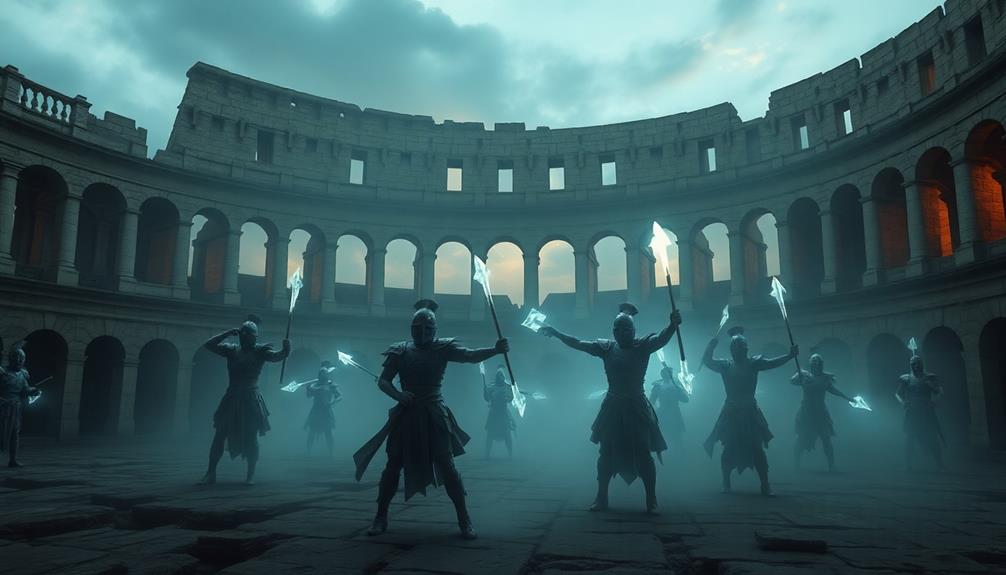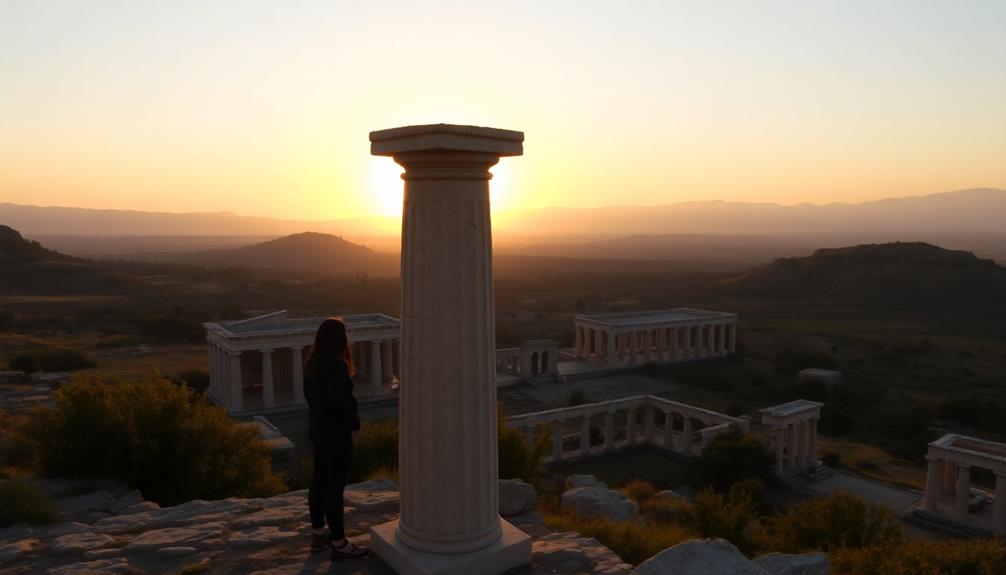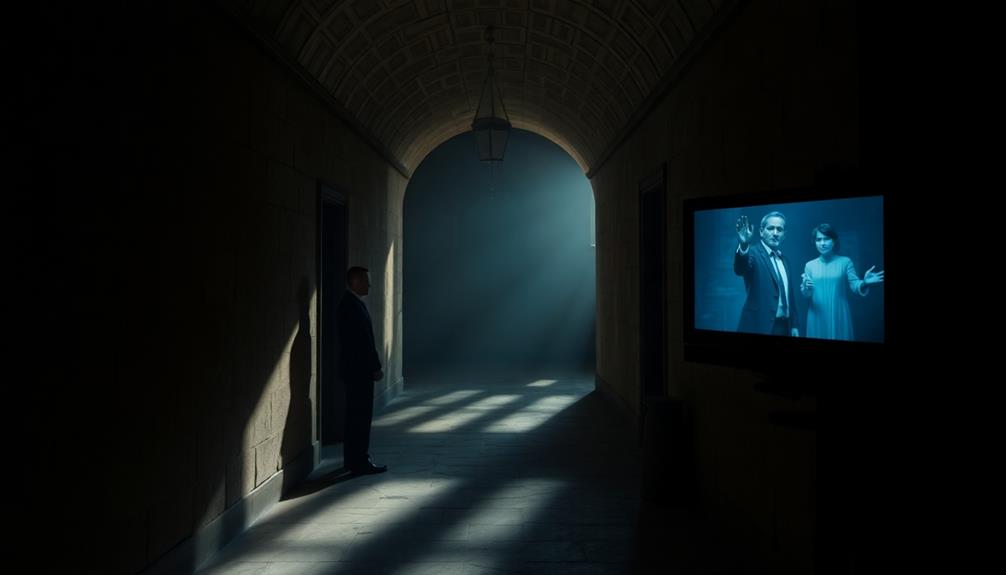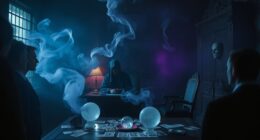Unexplained monk footprints have been found at Lucedio Abbey, sparking intrigue among ghost hunters and curiosity seekers. These footprints appear near the Judgement Room and mysteriously lead to and from the crypt, often vanishing without explanation. Many connect these eerie marks to dark rituals and the troubled history of the abbey, known for its haunted legends and supernatural occurrences. Some believe they're signs of restless spirits related to the abbey's dark past. As you explore further, you might uncover more chilling details about Lucedio's mysterious allure and its haunted tales awaiting discovery.
Key Takeaways
- Unexplained monk footprints were discovered near the Judgement Room of Lucedio Abbey, leading to and from the crypt associated with dark rituals.
- The footprints appear and disappear mysteriously, attracting ghost hunters and paranormal investigators searching for supernatural evidence.
- Historical records link the abbey to dark legends, including accusations of misconduct and witches' sabbaths, contributing to its haunting reputation.
- The Judgement Room is infamous for eerie sounds, tortured cries, and the presence of the "crying column," enhancing the site's ghostly atmosphere.
- The footprints are theorized to be remnants of restless spirits, possibly connected to traumatic events in the abbey's dark history.
The Discovery of Footprints

When you step into the eerie atmosphere of Lucedio Abbey, you can't help but feel the weight of its dark past. Among its many mysteries, the unexplained monk footprints have captured the attention of both paranormal investigators and historians.
Discovered near the infamous Judgement Room—where dark rituals and tortures reportedly occurred—these footprints add a chilling layer to the abbey's already eerie reputation.
Witnesses claim these footprints seem to lead to and from the crypt, a place believed to harbor an evil presence guarded by the mummified abbots. The sensation of being watched intensifies as you explore the area, especially knowing that investigators have noted the footprints appear and disappear without any logical explanation.
This phenomenon has become a focal point for ghost hunters keen to capture evidence of the supernatural.
As you investigate deeper into Lucedio Abbey, the air thick with history, you might find yourself questioning the origins of these mysterious footprints. Are they mere figments of imagination, or do they hint at the lingering spirits of monks who once walked these halls?
The answers remain elusive, but the intrigue continues to draw visitors from far and wide.
Historical Significance of Lucedio Abbey

Lucedio Abbey's historical significance starts with its monastic origins, established in 1123 by Cistercian monks dedicated to agriculture.
As you explore its agricultural innovations, you'll see how rice cultivation transformed the area and supported the community's growth.
However, the abbey's rich narrative is also shadowed by dark legends and folklore, adding layers to its intriguing past.
Monastic Origins and Growth
Founded in 1123, the Cistercian monks transformed a swampy expanse into the thriving Lucedio Abbey, establishing a model of manual labor and self-sufficiency.
Initially granted land by Reiner, Marquis of Montefract, these monks diligently cultivated the area, turning it into rich agricultural land primarily for rice production. This transformation not only marked the abbey as a significant monastic community but also positioned it as a crucial center for local agriculture and trade, boosting the economy of Trino and its surroundings.
As the years passed, Lucedio Abbey garnered attention through its involvement in the Crusades and benefactions from notable figures, including Pope Pius IX.
However, despite its early successes, the abbey's reputation began to wane due to allegations of dark practices. These rumors led to scrutiny and ultimately prompted action from the Vatican.
In 1784, Pope Pio VI issued a closure order for Lucedio Abbey, marking a significant turning point in its storied history. This change highlights the complexities of monastic life, where both spiritual devotion and societal perceptions could shape a community's fate dramatically.
Agricultural Innovations and Impact
The agricultural innovations introduced by the Cistercian monks at Lucedio Abbey greatly shaped the region's economy and agricultural practices. These monks, establishing the abbey in 1123, championed rice cultivation, transforming the swampy land into fertile paddies through innovative irrigation techniques.
This approach not only maximized productivity but also established Piedmont as a center for rice farming, reflecting the kind of competitive pricing strategies that drive agricultural markets. At its peak, Lucedio Abbey became a powerhouse in rice production, markedly boosting the local economy in Trino and surrounding areas.
The monks' commitment to agricultural excellence led to substantial harvests, which in turn fostered trade and commerce. The rice produced became a sought-after commodity, attracting merchants from local and regional markets.
This agricultural success played a critical role in sustaining the monastery and supporting the community, creating a symbiotic relationship between the abbey and the surrounding populace.
Even as Lucedio Abbey faced decline due to dark allegations, its legacy of agricultural innovations remains a proof of the impact of the Cistercian Order. Today, the abbey stands as a historic site, reflecting the profound advancements in agriculture that these monks brought to Italy.
Dark Legends and Folklore
Dark legends and haunting folklore surround Lucedio Abbey, casting a shadow over its once-revered agricultural legacy. Founded in 1123, the abbey evolved from a beacon of agricultural innovation to a site of accusations and dark practices. Tales of evil rituals and misconduct emerged, particularly stories of young girls luring monks into sin, leading to horrific abuses that necessitated papal investigations.
One of the most notorious places within the abbey is the Judgment Room, where monks decided the fates of many. This room is infamous for its rumored tortures and the haunting "crying column," believed to forever weep for the souls tormented there.
| Legend | Details |
|---|---|
| Witches' Sabbaths | Rituals reported as early as the 15th century |
| Evil Rituals | Allegations of demonic practices |
| Young Men Involved | Accounts of seduction leading to misconduct |
| Judgment Room's Reputation | Associated with torture and suffering |
The crypt below, where abbots are entombed in a seated position, supposedly guards an imprisoned evil spirit, deepening Lucedio Abbey's connection to the supernatural and reinforcing its dark legacy.
Theories Behind the Footprints

Mystery surrounds the unexplained monk footprints at Lucedio Abbey, sparking various theories about their origin.
Some believe these footprints are the lingering marks of the restless spirits of monks who once inhabited the site, a haunting reminder of the abbey's dark history. Paranormal investigators link the footprints to ghostly phenomena reported at the abbey, such as eerie screams and chanting, suggesting the presence of otherworldly entities.
Others propose that these footprints stem from the traumatic events that unfolded within the abbey, particularly in the infamous Judgement Room, known for its brutal torture practices.
Local folklore also plays a significant role in shaping these theories, pointing to ritualistic practices tied to alleged black magic and demonic rituals that plagued the abbey during its darkest years.
While skeptics argue that the footprints might simply be natural wear on the flooring, the consistent sightings and reports from visitors add to the enigma.
Each theory offers a glimpse into the possible origins of the footprints, leaving you to ponder the truth behind this lingering mystery at Lucedio Abbey.
Connection to Monastic Life

At Lucedio Abbey, the legacy of monastic life is palpable, with each footprint echoing the daily routines of the monks who once walked its halls. These monks adhered to the Cistercian Rule, which emphasized manual labor, prayer, and community. Their lives were intertwined with the land, particularly in agriculture, which was crucial for self-sufficiency.
| Aspect of Monastic Life | Description |
|---|---|
| Community | Monks shared responsibilities and lived in harmony, fostering deep connections. |
| Agriculture | They cultivated rice, ensuring food security and showcasing their agricultural expertise. |
| Spiritual Practices | Daily prayer and religious ceremonies reinforced their spiritual devotion. |
Every monk's presence was essential, contributing to the communal living arrangement. The abbey's influence extended beyond its walls, connecting with popes and noble patrons, which highlights the spiritual and agricultural significance of their work. The echoes of their disciplined lives resonate through the abbey today, reminding us of the profound impact these monks had on both their community and the region's agricultural landscape.
Legends and Myths Surrounding the Abbey

As you explore the legends surrounding Lucedio Abbey, you'll hear whispers of the Witches' Sabbath and the eerie tales of the Crying Column.
These stories add layers of intrigue to the abbey's history, suggesting a connection between the monks and the supernatural.
Each myth invites you to question the boundary between the sacred and the sinister, deepening the mystery of this ancient site.
Witches' Sabbath Legends
Legends surrounding Lucedio Abbey paint a chilling picture of the Witches' Sabbath, where it's said that witches gathered under the cover of darkness to perform ominous rituals.
These dark rituals often invoked the presence of Lucifer, and local folklore claims that young girls fell victim to the devil's seduction in their dreams. This corruption led to a disturbing influence over the monks living at the abbey.
Historical accounts describe the abbey as a notorious site for blasphemous black magic practices. Evidence of naked, bloodied young men discovered on the grounds prompted papal inquiries into the sinister activities taking place.
In the 17th century, rumors of sorcerers summoning demons near the abbey further cemented its reputation as a hub of dark sorcery.
Visitors and ghost hunters still flock to Lucedio, enthusiastic to experience the eerie atmosphere. Many recount chilling encounters with hooded figures roaming the grounds, believed to be remnants of those witches' gatherings.
These legends echo through the ages, weaving a tapestry of fear and fascination that surrounds Lucedio Abbey, leaving you to wonder what truly lurks in the shadows.
The Crying Column
What secrets does the Crying Column of Lucedio Abbey hold? This eerie structure, found in the Judgement Room, is said to weep perpetually, its moisture linked to the tears of tortured prisoners. While skeptics argue it's just a leaky roof, the dark history surrounding this haunted site suggests otherwise.
Imagine stepping into the room and feeling the weight of its past. You might notice:
- Chilling whispers echoing off the walls, remnants of torment.
- Shadows flickering in the corners, hinting at lost souls.
- A heavy silence that envelops you, as if time itself stands still.
Local legends assert the Crying Column symbolizes the abbey's cruel history, where monks passed brutal judgments on young male victims.
Paranormal investigators have flocked to this site, documenting unsettling sounds and sensations that linger in the air during their nocturnal explorations. The column's mysterious weeping has morphed into ghost stories, enhancing Lucedio Abbey's dark allure.
Each visit leaves you questioning the reality of the supernatural, as you ponder the suffering that echoes through time. What do you believe?
Paranormal Investigations at Lucedio

Paranormal investigations at Lucedio Abbey have captivated both enthusiasts and skeptics alike, with reports of unexplained phenomena adding to the site's eerie allure.
One of the most intriguing aspects of these investigations is the mysterious footprints resembling those of monks, which have appeared in various locations around the abbey. Investigators often find themselves drawn to the infamous Judgement Room, where eerie sounds like chanting and cries echo through the darkened halls.
This room, notorious for its chilling history, features the crying column, said to weep continuously, linked to the suffering of its past victims. As you explore, you might notice moving shadows and sudden cold spots that heighten the sense of unease.
The abbey's crypt, believed to house the spirits of mummified abbots, has also become a focal point for paranormal investigations. Here, claims of unusual energy and strange mists keep ghost hunters and paranormal experts returning in search of evidence.
With each investigation, the allure of Lucedio Abbey grows, fueled by the mysteries that await discovery within its ancient walls.
Visitor Experiences and Accounts

When you visit Lucedio Abbey, you might find yourself in the midst of eerie nighttime encounters that leave you questioning reality.
Visitors often report ghostly sounds echoing through the halls and unexplained visual phenomena that add to the abbey's haunting allure.
These experiences not only spark curiosity but also connect you to the enigmatic history of this remarkable site.
Eerie Nighttime Encounters
Unease permeates the air as visitors recount their eerie nighttime encounters at Lucedio Abbey. You step into the dimly lit corridors, where shadows dance and the atmosphere shifts. Many describe feeling an unsettling presence, as if unseen eyes are watching. Every creak of the floorboards heightens your senses, and you can't shake the feeling that you're not alone.
You might hear:
- Faint whispers echoing through the halls, almost like a distant chant.
- Sudden drops in temperature that send shivers down your spine.
- Shadowy figures resembling hooded monks gliding silently across the grounds.
These experiences leave an imprint on your mind, creating a haunting memory of the abbey. Some visitors have reported seeing ghostly monks wandering under the moonlight, their forms blending with the night.
The whispers grow louder during the full moon, enhancing the eerie atmosphere. As you explore, you can't help but feel the weight of history and the dark rituals that once occurred in the Judgment Room. Each step draws you deeper into the mystery of Lucedio Abbey, where the past lingers, waiting to be discovered.
Ghostly Sounds Reported
Countless visitors to Lucedio Abbey share chilling tales of ghostly sounds that haunt its ancient walls. Many recount hearing unexplained screams and eerie chanting, especially on full moon nights when the atmosphere feels particularly charged.
One of the most notorious spots is the Judgement Room, where the tortured cries of past victims seem to reverberate through time. As you explore this haunted place, you may find yourself gripped by a sense of unease, as if unseen eyes are watching your every move.
Paranormal investigators have gathered audio evidence that supports these spine-tingling experiences. They've captured indistinct voices and chilling whispers that add to the abbey's haunted reputation, making it a hotspot for ghost hunters and thrill-seekers alike.
Visitors often report feeling an overwhelming presence, enhancing the overall spooky atmosphere that surrounds the abbey.
Whether you're drawn by history or the supernatural, the ghostly sounds of Lucedio Abbey won't easily be forgotten. Each echo and whisper invites you deeper into its dark past, as you ponder the stories of those who once walked these halls.
Unexplained Visual Phenomena
The chilling tales of ghostly sounds at Lucedio Abbey are only part of the haunting experience that awaits visitors. As you explore the abbey, prepare to encounter unexplained visual phenomena that leave many in awe and fear.
You might witness:
- Shadowy figures resembling monks gliding silently through the grounds, vanishing as quickly as they appear.
- Flickering lights dancing near the crypt, casting eerie shadows that play tricks on your mind.
- The sudden drop in temperature, sending chills down your spine while you catch glimpses of those ghostly forms.
Many guests have reported seeing these fleeting images, often accompanied by the strange and unsettling sensation that they're not alone. Some describe footprints forming in the dust, leading mysteriously to the Judgement Room, a place with a dark history.
Paranormal investigations have uncovered audio recordings of chanting and whispers, heightening the sense of an otherworldly presence.
Each experience at Lucedio Abbey adds to the lore of this haunted site, where every corner holds the potential for another unexplained phenomenon.
Are you ready to discover what awaits you in the shadows?
The Role of Agriculture Today

In today's world, agriculture plays an essential role in both sustaining communities and preserving cultural heritage. At Lucedio Abbey, this connection comes alive through its operation as an organic rice farm. You'll discover how the Cistercian monks initially cultivated rice in this region, keeping their agrarian traditions alive even as time has marched on.
The farm employs sustainable practices that not only produce high-quality organic rice but also maintain ecological balance. Division of assets during times of change underscores the importance of agriculture in supporting local economies and families.
As you explore the abbey, you might find yourself intrigued by its haunting past. The once-abandoned fields now flourish with life, reminding visitors of the historical significance tied to agriculture in this area.
You can even participate in cooking classes that emphasize the role of rice in local cuisine, which promotes appreciation for both agricultural heritage and culinary skills.
Through these experiences, Lucedio Abbey fosters a vibrant agricultural community in Piedmont today, bridging the gap between the past and present. The abbey's activities contribute to local tourism, drawing in those enthusiastic to learn about its rich history and the essential role agriculture continues to play in our lives.
Cultural Impact of Lucedio Abbey

Exploring Lucedio Abbey offers a fascinating glimpse into its cultural impact, shaped by centuries of agricultural and supernatural narratives. This site isn't just a relic of the past; it's a living canvas for stories that blend history with the eerie.
- The haunting tales of monks wandering the darkened halls, whispering secrets of their past.
- The infamous "crying column" in the Judgement Room, a stark reminder of human suffering and sin.
- Allegations of witchcraft that swirl around the abbey, inviting curiosity and trepidation alike.
Lucedio Abbey stands as a representation of the rich tapestry of cultural narratives, weaving together its agricultural roots and its reputation as a haunted site.
The darker elements of its history, including misconduct among monks, have only intensified its allure, drawing paranormal enthusiasts enthusiastic to uncover the truth behind the legends.
As you wander through the abbey's storied grounds, you'll feel the weight of its past—both the beauty and the darkness.
This complex interplay between history, hauntings, and human curiosity continues to shape the cultural landscape of Piedmont, making Lucedio Abbey a significant landmark in Italy.
Broader Context of Haunted Sites

Haunted sites captivate the imagination, drawing visitors with their rich histories and chilling tales. Places like Lucedio Abbey are shrouded in mystery, featuring documented sightings and eerie sounds that attract both thrill-seekers and serious ghost hunters. These paranormal hotspots often possess narratives intertwining local folklore with significant historical events, contributing to their spooky reputations.
| Common Phenomena | Examples |
|---|---|
| Unexplained Footprints | Monk footprints at Lucedio |
| Strange Lights | Orbs seen near ancient ruins |
| Eerie Noises | Whispers heard in the dark |
At these haunted locations, you'll often encounter feelings of unease, with many visitors reporting supernatural encounters ranging from fleeting shadows to full apparitions. The cultural significance of these sites often stems from tragic events that supposedly manifest as paranormal activity. Ghost hunters and paranormal investigators flock to these places, enthusiastic to uncover the mysteries behind the unexplained. Whether you're a skeptic or a believer, the allure of haunted sites remains irresistible, promising an experience that blends history with the supernatural.
Conclusion
So, as you stroll through Lucedio Abbey, you might just find yourself stepping in the same footprints left behind by monks centuries ago. Ironically, while these ghostly traces spark curiosity about the past, they also remind you how little we truly know. You're surrounded by history, yet the unanswered questions linger like the echoes of prayers once whispered in the cloisters. Perhaps the real mystery isn't the footprints themselves, but how they connect us to a world we can barely grasp.










